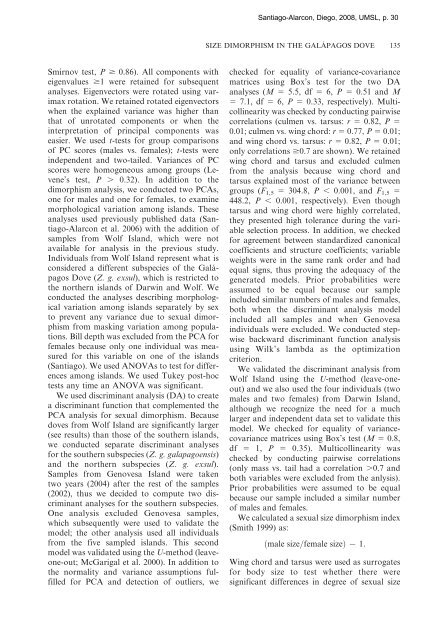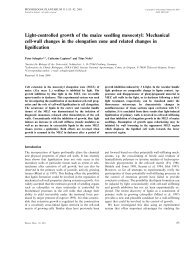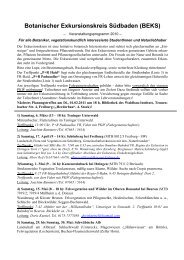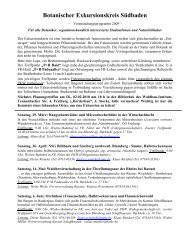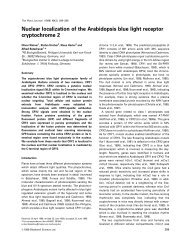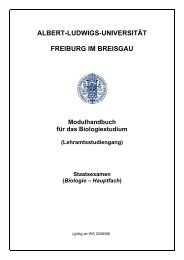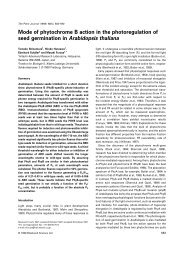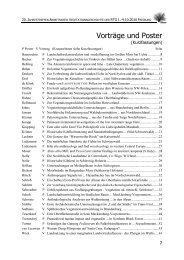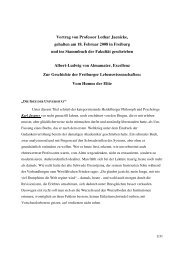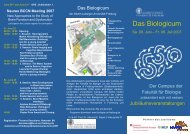SEXUAL SIZE DIMORPHISM AND MORPHOLOGICAL EVIDENCE ...
SEXUAL SIZE DIMORPHISM AND MORPHOLOGICAL EVIDENCE ...
SEXUAL SIZE DIMORPHISM AND MORPHOLOGICAL EVIDENCE ...
Create successful ePaper yourself
Turn your PDF publications into a flip-book with our unique Google optimized e-Paper software.
Smirnov test, P $ 0.86). All components with<br />
eigenvalues $1 were retained for subsequent<br />
analyses. Eigenvectors were rotated using varimax<br />
rotation. We retained rotated eigenvectors<br />
when the explained variance was higher than<br />
that of unrotated components or when the<br />
interpretation of principal components was<br />
easier. We used t-tests for group comparisons<br />
of PC scores (males vs. females); t-tests were<br />
independent and two-tailed. Variances of PC<br />
scores were homogeneous among groups (Levene’s<br />
test, P . 0.32). In addition to the<br />
dimorphism analysis, we conducted two PCAs,<br />
one for males and one for females, to examine<br />
morphological variation among islands. These<br />
analyses used previously published data (Santiago-Alarcon<br />
et al. 2006) with the addition of<br />
samples from Wolf Island, which were not<br />
available for analysis in the previous study.<br />
Individuals from Wolf Island represent what is<br />
considered a different subspecies of the Galápagos<br />
Dove (Z. g. exsul), which is restricted to<br />
the northern islands of Darwin and Wolf. We<br />
conducted the analyses describing morphological<br />
variation among islands separately by sex<br />
to prevent any variance due to sexual dimorphism<br />
from masking variation among populations.<br />
Bill depth was excluded from the PCA for<br />
females because only one individual was measured<br />
for this variable on one of the islands<br />
(Santiago). We used ANOVAs to test for differences<br />
among islands. We used Tukey post-hoc<br />
tests any time an ANOVA was significant.<br />
We used discriminant analysis (DA) to create<br />
a discriminant function that complemented the<br />
PCA analysis for sexual dimorphism. Because<br />
doves from Wolf Island are significantly larger<br />
(see results) than those of the southern islands,<br />
we conducted separate discriminant analyses<br />
for the southern subspecies (Z. g. galapagoensis)<br />
and the northern subspecies (Z. g. exsul).<br />
Samples from Genovesa Island were taken<br />
two years (2004) after the rest of the samples<br />
(2002), thus we decided to compute two discriminant<br />
analyses for the southern subspecies.<br />
One analysis excluded Genovesa samples,<br />
which subsequently were used to validate the<br />
model; the other analysis used all individuals<br />
from the five sampled islands. This second<br />
model was validated using the U-method (leaveone-out;<br />
McGarigal et al. 2000). In addition to<br />
the normality and variance assumptions fulfilled<br />
for PCA and detection of outliers, we<br />
Santiago-Alarcon, Diego, 2008, UMSL, p. 30<br />
<strong>SIZE</strong> <strong>DIMORPHISM</strong> IN THE GALÁPAGOS DOVE 135<br />
checked for equality of variance-covariance<br />
matrices using Box’s test for the two DA<br />
analyses (M 5 5.5, df 5 6, P 5 0.51 and M<br />
5 7.1, df 5 6, P 5 0.33, respectively). Multicollinearity<br />
was checked by conducting pairwise<br />
correlations (culmen vs. tarsus: r 5 0.82, P 5<br />
0.01; culmen vs. wing chord: r 5 0.77, P 5 0.01;<br />
and wing chord vs. tarsus: r 5 0.82, P 5 0.01;<br />
only correlations $0.7 are shown). We retained<br />
wing chord and tarsus and excluded culmen<br />
from the analysis because wing chord and<br />
tarsus explained most of the variance between<br />
groups (F 1,5 5 304.8, P , 0.001, and F 1,5 5<br />
448.2, P , 0.001, respectively). Even though<br />
tarsus and wing chord were highly correlated,<br />
they presented high tolerance during the variable<br />
selection process. In addition, we checked<br />
for agreement between standardized canonical<br />
coefficients and structure coefficients; variable<br />
weights were in the same rank order and had<br />
equal signs, thus proving the adequacy of the<br />
generated models. Prior probabilities were<br />
assumed to be equal because our sample<br />
included similar numbers of males and females,<br />
both when the discriminant analysis model<br />
included all samples and when Genovesa<br />
individuals were excluded. We conducted stepwise<br />
backward discriminant function analysis<br />
using Wilk’s lambda as the optimization<br />
criterion.<br />
We validated the discriminant analysis from<br />
Wolf Island using the U-method (leave-oneout)<br />
and we also used the four individuals (two<br />
males and two females) from Darwin Island,<br />
although we recognize the need for a much<br />
larger and independent data set to validate this<br />
model. We checked for equality of variancecovariance<br />
matrices using Box’s test (M 5 0.8,<br />
df 5 1, P 5 0.35). Multicollinearity was<br />
checked by conducting pairwise correlations<br />
(only mass vs. tail had a correlation .0.7 and<br />
both variables were excluded from the anlysis).<br />
Prior probabilities were assumed to be equal<br />
because our sample included a similar number<br />
of males and females.<br />
We calculated a sexual size dimorphism index<br />
(Smith 1999) as:<br />
ðmale size=female sizeÞ<br />
{ 1:<br />
Wing chord and tarsus were used as surrogates<br />
for body size to test whether there were<br />
significant differences in degree of sexual size


